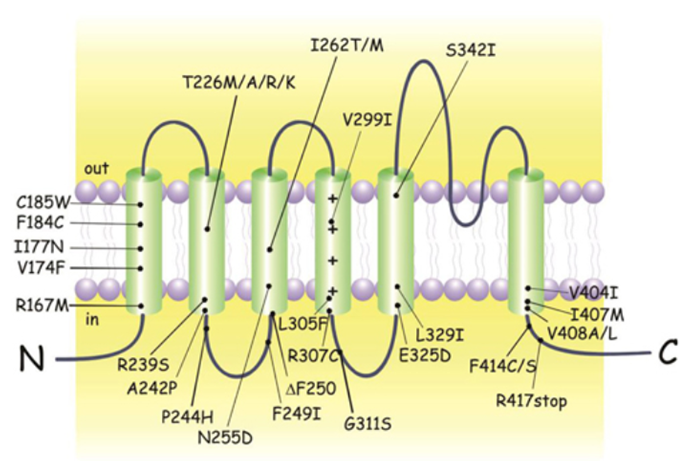- Home
-
Screening
- Ionic Screening Service
-
Ionic Screening Panel
- Sodium Channels
- Potassium Channels
- Chloride Channels
- Calcium Channels
- TRP Channels
- ATP gated P2X Channels
- ASICs
- Nicotinic Acetylcholine Receptors
- Ionotropic Glutamate-gated Receptors
- GABAa Receptors
- Glycine Receptors
- 5-HT Receptors3
- Cystic Fibrosis Transmembrane Conductance Regulators (CFTR)
- Other Ion Channels
- Stable Cell Lines
- Cardiology
- Neurology
- Ophthalmology
-
Platform
-
Experiment Systems
- Xenopus Oocyte Screening Model
- Acute Isolated Cardiomyocytes
- Acute Dissociated Neurons
- Primary Cultured Neurons
- Cultured Neuronal Cell Lines
- iPSC-derived Cardiomyocytes/Neurons
- Acute/Cultured Organotypic Brain Slices
- Oxygen Glucose Deprivation Model
- 3D Cell Culture
- iPSC-derived Neurons
- Isolation and culture of neural stem/progenitor cells
- Animal Models
- Techinques
- Resource
- Equipment
-
Experiment Systems
- Order
- Careers
- Home
- Symbol Search
- KCNA1
KCNA1
| Catalog | Product Name | Gene Name | Species | Morphology | Price |
|---|---|---|---|---|---|
| ACC-RI0026 | Human KCNA1 Stable Cell Line-CHO | KCNA1 | Human | Epithelial-like | INQUIRY |
| ACC-RI0121 | Human KCNA1 Stable Cell Line-HEK293 | KCNA1 | Human | Epithelial | INQUIRY |
KCNA1 gene is a member of a large family of genes that provide instructions for the formation of potassium channels. These channels can transport positively charged potassium atoms (ions) in and out of the cell, and play a key role in the cell's ability to generate and transmit electrical signals. The KCNA1 gene provides instructions for making the alpha subunit of the potassium channel Kv1.1. These channels exist in the brain, where they transport potassium ions to nerve cells. The flow of potassium ions in and out of neurons regulates the communication between these cells.
KCNA1 Discovery and Cloning
Ramaswami et al. used primers based on the conserved region between Drosophila Shaker and mouse voltage-gated potassium channels to perform PCR on genomic DNA to isolate several related human gene fragments. They used these fragments to screen a cDNA library and cloned cDNAs encoding several potassium channels and designated them as HuKI (KCNA1), HuKII (KCNA4), HuKIV (KCNA2) and HuKV (KCNA6). Like other shaker potassium channels, the predicted 495 amino acid KCNA1 protein contains 6 hydrophobic segments, a positively charged region called S4 between hydrophobic segments 3 and 4 and a leucine zipper. KCNA1 has 98% amino acid homology with its rat homologue RCK1. When KCNA1, KCNA4 and KCNA2 are expressed in Xenopus oocytes, they exhibit different voltage dependence, kinetics and sensitivity to pharmacological potassium channel blockers. Among them, KCNA1 and KCNA2 are non-inactivation channels, similar to delayed rectifiers, while KCNA4 is a fast inactivation channel.
KCNA1 and Disease
At least 20 KCNA1 gene mutations have been found in patients with episodic ataxia type 1 (EA1). People with this disease have transient, recurring episodes of poor coordination and balance (ataxia). Between attacks, many patients experience dyskinesia, a muscle abnormality that can cause involuntary muscle spasms, stiffness, and continuous twitching of fine muscles, which appear as ripples under the skin. Most KCNA1 mutations cause occasional ataxia, altering a single amino acid sequence in the alpha subunit of the Kv1.1 channel. Some of these changes prevent the assembly of functional channels, while other mutations change the structure of the channels. When the Kv1.1 channel is missing or abnormal, the flow of potassium ions into the neuron decreases. The reduction of potassium ions will over-stimulate certain neurons in the brain, thereby disrupting the normal communication between these cells. Although changes in interneuronal signals are the cause of uncoordinated motor episodes in patients with occasional ataxia, it is not clear how changes in potassium ion transport lead to the specific characteristics of this disease.

Figure 1. KCNA1 mutations identified in episodic ataxia type 1 (EA1) individuals.(D'Adamo MC, et al.; 2015)
Other Disorders
Mutations in the KCNA1 gene have been found to cause a series of signs and symptoms that affect the nervous system. In at least one family, isolated dyskinesia (continuous muscle twitches and spasms, no ataxia episodes) is believed to be caused by KCNA1 mutations. Changes in this gene have also been found in a small number of patients with epilepsy. Like KCNA1 mutations that cause occasional ataxia, mutations that cause isolated dyskinesia and epilepsy reduce the flow of potassium ions through Kv1.1 channels, disrupting normal communication between neurons in the brain. Researchers are working to determine why this single gene mutation can cause several different neurological disorders.
References
- Browne DL, et al.; Episodic ataxia/myokymia syndrome is associated with point mutations in the human potassium channel gene, KCNA1. Nat Genet. 1994 Oct;8(2):136-40.
- Chen H, et al.; Functional analysis of a novel potassium channel (KCNA1) mutation in hereditary myokymia. Neurogenetics. 2007, 8(2):131-5.
- Eunson LH, et al.; Clinical, genetic, and expression studies of mutations in the potassium channel gene KCNA1 reveal new phenotypic variability. Ann Neurol. 2000, 48(4):647-56.
- Maylie B, et al.; Episodic ataxia type 1 mutations in the human Kv1.1 potassium channel alter hKvbeta 1-induced N-type inactivation. J Neurosci. 2002, 22(12):4786-93.
- Zerr P, et al.; Episodic ataxia mutations in Kv1.1 alter potassium channel function by dominant negative effects or haploinsufficiency. J Neurosci. 1998, 18(8):2842-8.
- Ramaswami, M., et al.; Human potassium channel genes: molecular cloning and functional expression. Molec. Cell. Neurosci. 1990, 1: 214-223.
- D'Adamo MC, et al.; New insights into the pathogenesis and therapeutics of episodic ataxia type 1. Front Cell Neurosci. 2015, 9:317.
Inquiry
